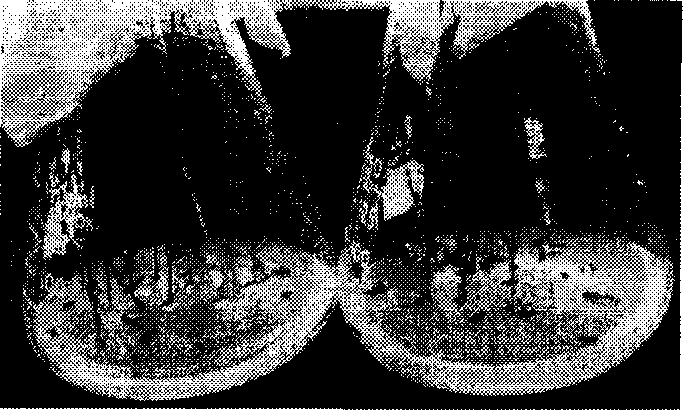Method of cultivating drought tolerance high fescue
A technology for tall fescue and seeds, which is applied in the fields of botanical equipment and methods, horticulture, and application to achieve the effects of high controllability, reliable technical measures, and easy and fast operation.
- Summary
- Abstract
- Description
- Claims
- Application Information
AI Technical Summary
Problems solved by technology
Method used
Image
Examples
Embodiment 1
[0055] Embodiment 1, acquisition of drought-tolerant tall fescue and detection of transgenic plants thereof
[0056] 1. Induction of embryogenic callus
[0057] 1. Disinfection of seeds: Soak the seeds of tall fescue species antelope in sterile water for 1-3 hours, disinfect with 70% alcohol for 30 seconds, rinse with sterile water for 3-5 times, and disinfect with 50% sodium hypochlorite for 20-25 minutes, without stopping Shake vigorously and rinse with sterile water 3-5 times.
[0058] 2. Inoculate the sterilized tall fescue seeds on the seed inoculation medium, and cultivate them at 26 ± 1° C. under light 12h / d. After 3 days, the seeds begin to germinate, and about 20 days into seedlings ( figure 1 ).
[0059] 3. When the seedling grows to a height of about 2-5cm, under sterile conditions, cut about 0.5-1cm of the hypocotyl at the base of the seedling as an explant, such as figure 2 As shown, it was inoculated on the callus induction medium and cultured in the dark at ...
Embodiment 2
[0100] Example 2, analysis of glufosinate resistance of transgenic tall fescue plants
[0101] Select leaves with similar growth, area, and color from transgenic plants and control plants with basically similar morphological indicators such as plant height and growth, apply 2 mg / L glufosinate solution evenly on the leaves with a brush, and observe the growth of the leaves at any time. Variety. After smearing tall fescue leaves with glufosinate for 3 days, the leaves of the control plants began to show injury reactions, mainly manifested as leaf growth slowing down, the color of the leaves changed from dark green to light green, and the leaves of the transgenic plants turned from light yellow to white after 7 days, while the leaves of the transgenic plants Only slight injury symptoms appeared in individual parts. It was preliminarily confirmed that the Bar gene had been expressed in the recipient plants, endowing the recipient plants with glufosinate resistance, and the result...
Embodiment 3
[0102] Embodiment 3, the proline content determination of transgenic tall fescue plant
[0103] The proline content of tall fescue leaves of transgenic tall fescue plants with normal watering and control non-transgenic plants were determined. The determination method can refer to (Zhang Dianzhong, Wang Peihong, Zhao Huixian. Method for measuring free proline content of wheat leaves. Plant Physiol Letters, 1990, (4): 62-65). Take the average data of 4 independent experiments as the examination questions. Using the sulfosalicylic acid method, the proline content of the leaves of the normally watered transgenic plants and the control plants was measured, and the results were as follows: Figure 11 Shown (2-5 is the transgenic plant, 1 is the control plant). Tall fescue showed that the proline content of the control plants was 100%, and the proline content of the leaves of the transgenic plants was 31%-83% higher than that of the control plants, implying that the target gene had...
PUM
 Login to View More
Login to View More Abstract
Description
Claims
Application Information
 Login to View More
Login to View More - R&D
- Intellectual Property
- Life Sciences
- Materials
- Tech Scout
- Unparalleled Data Quality
- Higher Quality Content
- 60% Fewer Hallucinations
Browse by: Latest US Patents, China's latest patents, Technical Efficacy Thesaurus, Application Domain, Technology Topic, Popular Technical Reports.
© 2025 PatSnap. All rights reserved.Legal|Privacy policy|Modern Slavery Act Transparency Statement|Sitemap|About US| Contact US: help@patsnap.com



